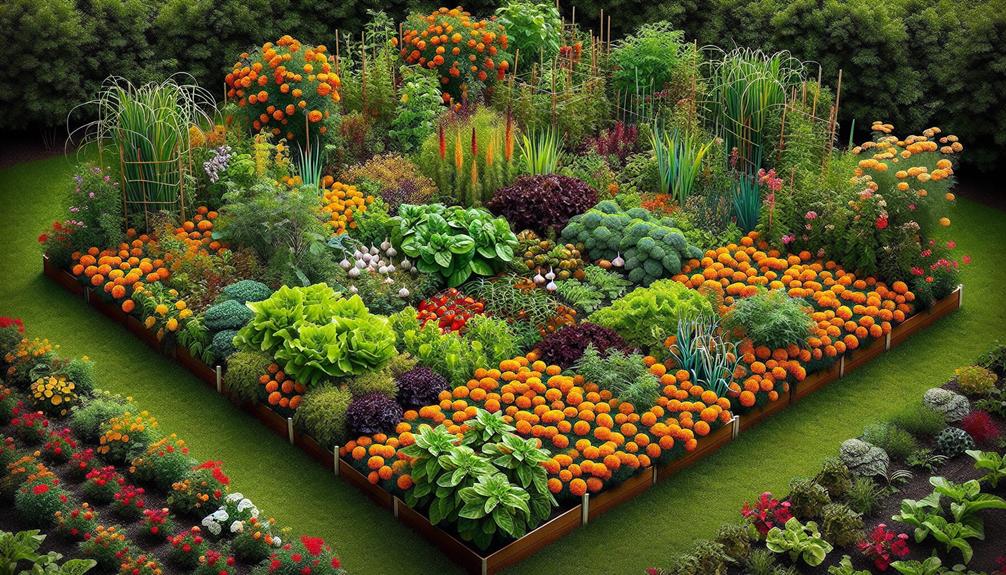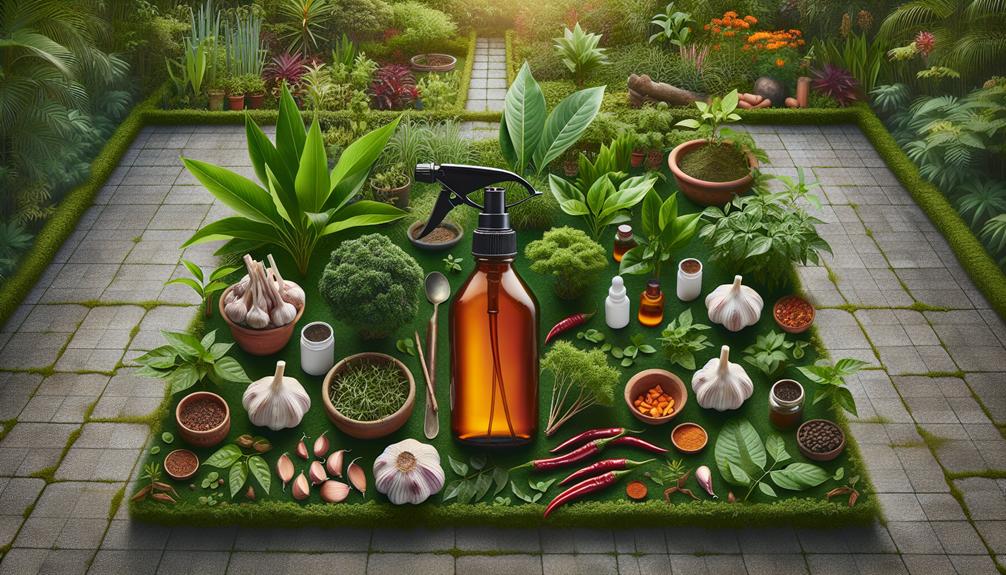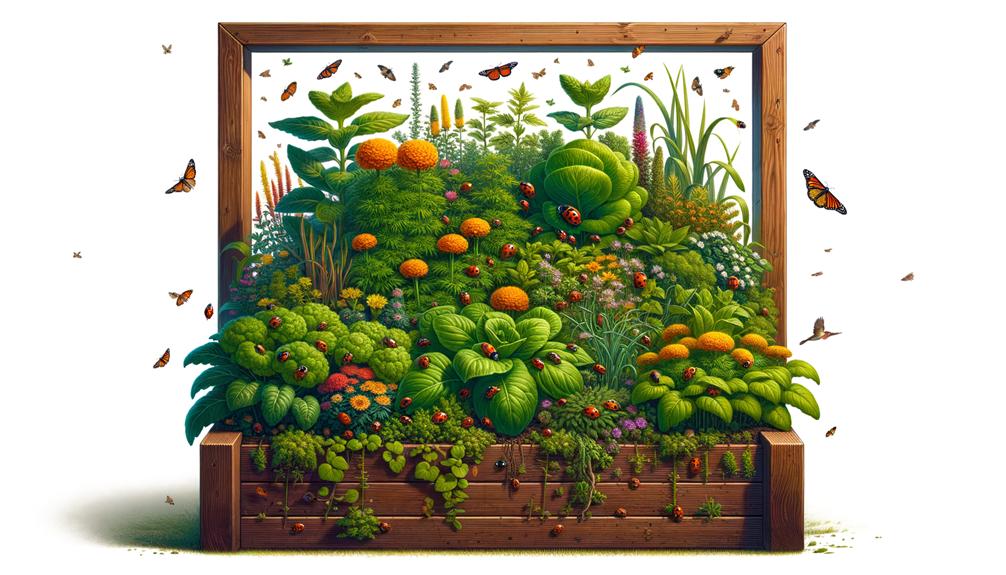Did you know that gardeners who use organic pest control methods can reduce pesticide use by up to 75%? As you strive to maintain a vibrant square foot garden, the push towards sustainable and eco-friendly practices has never been more critical.
You’re not just looking to grow food or flowers; you’re cultivating an ecosystem that supports life in all its forms. Whether it’s through companion planting techniques that naturally deter pests or introducing beneficial insects that keep harmful critters at bay, the options are both effective and fascinating.
But how do you implement these methods without compromising the health of your garden? Let’s explore together how you can harness the power of nature to protect your square foot garden, ensuring it thrives in harmony with the environment around it.
1. Companion Planting Techniques

To effectively deter pests in your square foot garden, it’s essential to understand and implement companion planting techniques that promote a healthy, balanced ecosystem. By strategically placing certain plants next to each other, you’re not just maximizing space but also enhancing your garden’s resilience against pests naturally. This method doesn’t only repel unwanted insects but also attracts beneficial ones, ensuring your plants thrive.
Incorporating crop rotation into your companion planting plan is a smart move. It prevents pests from becoming established by disrupting their life cycles. Since pests often prefer specific plants, changing what you plant in each square foot from season to season reduces the chance of infestation.
This practice also plays a crucial role in maintaining soil health, as different plants have varied nutrient needs and contributions. By rotating crops, you ensure that the soil’s nutrients are used and replenished in a balanced way, preventing depletion and fostering a rich, fertile ground for your plants to grow in.
2. Natural Predators Integration

Integrating natural predators into your square foot garden is a highly effective, eco-conscious strategy to keep pest populations in check. By welcoming beneficial insects and animals, you’re employing a method that works harmoniously with nature, reducing the need for chemical pesticides.
Here’s how to make your garden a haven for these allies:
- Create Diverse Predator Habitats: Diversify your garden’s ecosystem by incorporating flowering plants, shrubs, and small water sources. These additions offer shelter and alternative food sources for predators like ladybugs, lacewings, and birds, making your garden more inviting for them.
- Understand Seasonal Timing: Certain pests emerge at specific times of the year, and so do their natural predators. Timing the introduction of predator habitats to match the life cycle of common pests can enhance the effectiveness of this method. For instance, installing a bat house in early spring can help control mosquito populations throughout the warmer months.
- Avoid Broad-Spectrum Pesticides: These can harm beneficial insects alongside the pests. If you must use pesticides, opt for targeted, organic options that are less likely to disrupt your garden’s natural predator-prey balance.
3. Neem Oil Applications

You’ve learned how integrating natural predators can bolster your garden’s defenses against pests.
Now, let’s explore the world of Neem Oil, a cornerstone in eco-friendly pest management. Its benefits and application techniques can significantly enhance your square foot garden’s health and productivity without compromising the environment.
Neem Oil Benefits
Neem oil, a versatile and eco-friendly option, effectively combats a wide range of garden pests without harming beneficial insects. Originating from the neem tree, it’s renowned for its minimal health impacts compared to synthetic pesticides.
Here are three key benefits of using neem oil in your square foot garden:
- Eco-Friendly: It’s a renewable, biodegradable solution that doesn’t contribute to environmental pollution.
- Selective Action: Specifically targets pests, preserving pollinators like bees and beneficial predators.
- Disease Prevention: Besides pest control, neem oil can help prevent fungal diseases, enhancing plant health.
Application Techniques
To effectively harness the benefits of neem oil in your square foot garden, it’s crucial to master the proper application techniques.
Begin by integrating soil amendments to ensure your garden’s foundation is nutrient-rich and receptive to neem oil’s properties.
Optimal watering practices are also key; water your plants early in the day so the leaves have time to dry before applying neem oil. This minimizes the risk of fungal diseases.
When applying neem oil, mix it with water according to the product’s instructions, then use a spray bottle to evenly coat the leaves, both the tops and undersides, where pests often hide.
Doing this late in the evening helps avoid direct sunlight, which can diminish the oil’s effectiveness.
4. Diatomaceous Earth Usage

Diatomaceous earth, a naturally occurring, non-toxic powder, can effectively deter pests in your square foot garden without harming the environment. It’s made from the fossilized remains of tiny, aquatic organisms called diatoms. Their skeletons are made of a natural substance called silica. When ground into a fine powder, diatomaceous earth works wonders in pest control, but there are a few things you need to know to use it effectively and safely.
Here are three key points to consider:
- Health Precautions: While diatomaceous earth is non-toxic, it’s still a fine powder that can irritate the lungs if inhaled. Always wear a mask when applying it to your garden. Avoid getting it on your skin or in your eyes, as it can be drying or mildly irritating.
- Water Interaction: Diatomaceous earth loses its effectiveness when wet. Apply it on a dry day and reapply after watering your garden or after rain.
- Application Method: Lightly dust the soil surface around your plants. You can also sprinkle it directly on the leaves, but remember, it needs to be dry to work.
5. Beneficial Insects Introduction

Harnessing the power of beneficial insects can naturally bolster your garden’s defenses against pests, providing an eco-friendly alternative to chemical treatments. By inviting these natural allies into your square foot garden, you’re not only reducing your reliance on harmful pesticides but also contributing to the preservation of biodiversity.
Creating insect habitats and pollinator gardens are pivotal strategies in this organic pest control method. Introducing beneficial insects starts with understanding which species are allies for your specific crops. Ladybugs, for example, are voracious predators of aphids, while lacewings tackle a variety of pests including whiteflies and mites. By planting flowers and herbs that attract these beneficial insects, you’re essentially setting up a buffet that invites them into your garden.
Insect habitats can range from simple to elaborate. A basic approach involves leaving some areas of your garden a little wild, with native plants and undisturbed leaf litter where insects can thrive. For a more structured approach, consider building or buying insect hotels, which provide nesting sites for a variety of beneficial species.
Pollinator gardens, filled with nectar and pollen-rich plants, are essential in attracting and sustaining populations of bees and butterflies, which, aside from pollinating your plants, also play a role in pest management. By integrating these strategies, you’re not just growing a garden; you’re nurturing a vibrant, self-sustaining ecosystem.
6. Homemade Organic Sprays

Beyond the realm of beneficial insects, you can also create homemade organic sprays that effectively deter pests without harming your garden’s ecosystem. By using simple ingredients you likely already have at home, you can concoct solutions that aren’t only cost-effective but also environmentally friendly.
Here are three recipes to get you started:
- Garlic Infusion
- Crush a few cloves of garlic and mix them with two cups of water. Allow this mixture to infuse overnight. The next day, strain the garlic pieces out and pour the infused water into a spray bottle. This potent solution repels a wide range of pests, thanks to garlic’s natural insect-repellent properties.
- Soap Mixture
- Combine one tablespoon of biodegradable liquid soap with a quart of water. This soap mixture works by breaking down the outer layer of pests, effectively dehydrating and killing them without using harsh chemicals.
- Neem Oil Spray
- Mix two teaspoons of neem oil with a quart of water and a few drops of mild liquid soap. Neem oil, derived from the neem tree, acts as a natural pesticide that’s safe for plants but deadly for pests.
7. Barrier and Trap Strategies

Moving on to barrier and trap strategies, you’ll find that setting up physical barriers and deploying traps can be a game-changer in protecting your square foot garden from pests.
These methods not only prevent unwanted guests but also support a healthy, chemical-free environment for your plants.
Let’s explore how to effectively use physical barrier techniques and traps to keep your garden thriving.
Physical Barrier Techniques
To effectively protect your square foot garden, implementing physical barrier techniques and trap strategies can significantly reduce pest invasions without harming the environment. These methods aren’t only eco-friendly but also promote a healthy, balanced ecosystem within your garden space. Here are three practical steps you can take:
- Mulching Methods: Apply organic mulches around your plants. This not only retains soil moisture and regulates temperature but also deters certain pests.
- Soil Amendments: Incorporate compost or other organic soil amendments to improve soil health. Healthy soil supports plant resilience against pests.
- Physical Barriers: Use floating row covers or insect netting to physically block pests from reaching your plants. These can be especially effective against larger pests and can easily be removed to allow for pollination when necessary.
Effective Trap Deployment
In addition to implementing barrier methods, setting up effective traps is a key strategy for naturally managing pests in your square foot garden. By thoughtfully placing traps, you’re not just catching pests; you’re also monitoring their activity, which informs your ongoing pest control efforts.
It’s vital to integrate traps with other organic practices, like crop rotation and soil amendments, to create a resilient garden ecosystem. Crop rotation disrupts pest life cycles, while soil amendments enhance plant health, making your garden less inviting to pests.
For instance, a simple beer trap can lure and trap slugs, but when combined with healthy soil practices, your garden becomes robust against invasions. Remember, it’s about creating a balance that encourages beneficial insects while deterring harmful ones.

